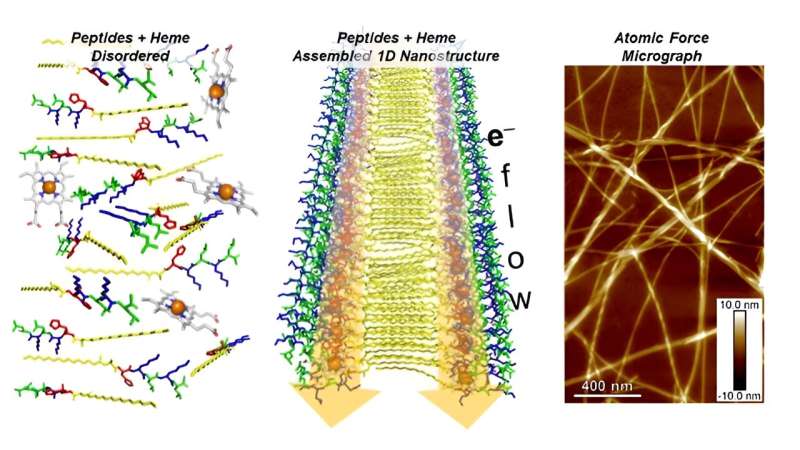This article has been reviewed according to Science X's editorial process and policies. Editors have highlighted the following attributes while ensuring the content's credibility:
fact-checked
peer-reviewed publication
trusted source
proofread
Nature inspires a new wave of biotechnology

Biological molecules called peptides play a key role in many biological activities, including the transport of oxygen and electrons. Peptides consist of short chains of amino acids, the building blocks of proteins. They are also the inspiration for new kinds of biotechnology.
Researchers are developing a synthetic form of a peptide that self-assembles into nanoscale fibers that conduct electricity when combined with heme. Heme is a substance that helps proteins in nature move electrons from one place to another.
The researchers determined how electrical conductivity of their peptide nanofibers was affected by the length of the sequence of amino acids in the peptide and their identity
Structural parameters of peptides in nature determine their function and their promise for biotechnology. These parameters include sequence length—the length of the peptide segments that make up complete peptide chains. They also include how some amino acids are arranged in a peptide. The research was published in the journal Nanoscale in June 2022.
This study's results help researchers design peptide assemblies that form nanoscale fibers and transport electrons over long distances, which could make these fibers useful in medical devices, biosensors for a wide range of applications, and robotics. They also have promise in the development of new enzymes, which companies use to make and improve things such as medical-grade and household cleaning products.
Fields in materials and biochemistry research explore protein and peptide nanostructures found in nature. These nanostructures show great promise as bioelectronic materials. The development of a synthetic analog capable of forming one-dimensional (1D) nanostructures would greatly improve scientists' understanding of the natural system and provide a platform for developing new materials.
Researchers at the Center for Nanoscale Materials at Argonne National Laboratory investigated a series of peptides that self-assemble into 1D layered nanostructures. The peptides PA-(Kx)n are denoted simply as PA-Kxn, where PA is c16-AH with c16-A being modified alanine (A) and H is histidine, K is lysine, n is the sequence repeat length (1–4), and x is the amino acid leucine (L), isoleucine (I), or phenylalanine (F).
The team determined how the length of the peptide sequence (n) and the identity of the hydrophobic amino acid affect key factors: the binding affinity of heme to pre-assembled peptides, the heme density, and the electronic properties.
With a sequence length of 2, the peptide assembly yielded the greatest binding affinity. The resulting nanoscale assemblies produced ordered arrays of the electroactive molecule heme. All the peptides, with the exception of PA-KL1, had nanofibers with a long aspect ratio regardless of repeat unit length and sequence. Such structures have potential utility as supramolecular bioelectronic materials useful in biomedical sensing and the development of enzymatic materials.
More information: H. Christopher Fry et al, Designing 1D multiheme peptide amphiphile assemblies reminiscent of natural systems, Nanoscale (2022). DOI: 10.1039/D2NR00473A
Journal information: Nanoscale
Provided by US Department of Energy





















